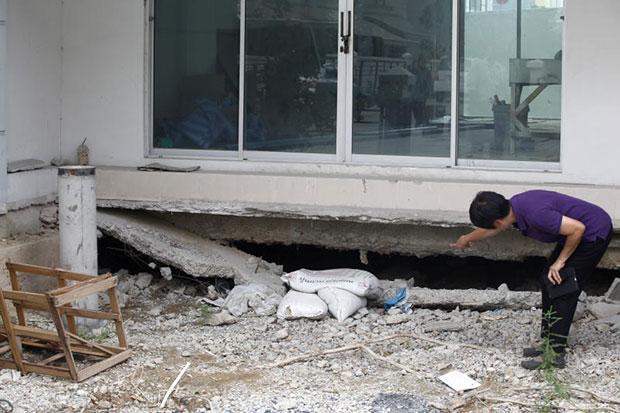Residents told to wait 6 months for repairs

An engineering team inspects the land substance at the Baan Klang Krung housing estate in Ratchavipha on Monday. (Bangkok Post photo)
Heavy land subsidence has been found in parts of the Baan Klang Krung housing estate in Ratchavipha after a team of Engineering Institute of Thailand (EIT) experts inspected the area.
The team told residents to avoid repairing their homes until after a ground analysis has been carried out, which could take six months.
The institute found some areas around certain homes and adjacent streets have subsided by between 50-100 cm, which is more than usual. The subsidence started three years ago, according to reports.
The inspection came after the EIT received complaints from owners of about 200 homes in the estate. Of that number, 69 homes have heavy land subsidence.
EIT chairman Suchatvee Suwansawat, who led the inspection team, said three-storey town homes located in the second phase of the estate were the worst affected. Damage to these homes tends to be situated around the houses, parking space, the front and back of the houses, and the adjacent streets.
Mr Suchatvee said the houses in the subsidence areas are structurally strong but it is surprising to find land subsiding between 50-100 cm as it has done over the past three years.
The priority now is to analyse the soil over the affected areas to study the subsidence, and form an accurate overview of the problem.
The EIT chairman said the severity of subsidence varies from location to location due to different soils used in landfill.
The condition of the land in various areas of the estate prior to the landfill is also different.
These are the types of factors which engineers must take into consideration when they determine what underground pillars to use for a housing project, he said.
A housing developer must have proper knowledge about the soil and what procedures to carry out when it comes to landfill.
Without it, the landfill could trigger or aggravate the subsidence because placing too much soil in an area could put excessive weight on the original land.
The EIT has collected information and soil samples from the estate to be examined.
After that, the institute will calculate the precise level of subsidence at various locations of the estate before working out the methods of repair.
Central to measuring the subsidence is establishing a benchmark, or finding a spot least prone to sinking.
The degrees of subsidence in other areas will be measured against the benchmark.
The analysis will take six months because there are wide areas to measure and benchmark, according to the EIT.
The institute also told residents not to rush into making repairs on their homes as they may not always help.
Mr Suchatvee said some homeowners have already started making repairs by installing large underground pillars, which are expensive and may not be effective in tackling the subsidence.
The EIT has advised those undertaking repairs to make sure the work does not interfere with the foundations of the houses, which remain sound.
If the repair to the areas around the house is not conducted properly, it may worsen the subsidence.
Source: http://www.bangkokpost.com/news/general/611544/estate-subsidence-goes-back-3-years

